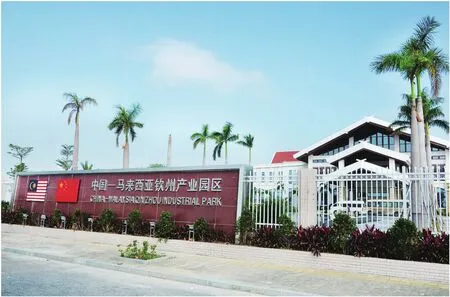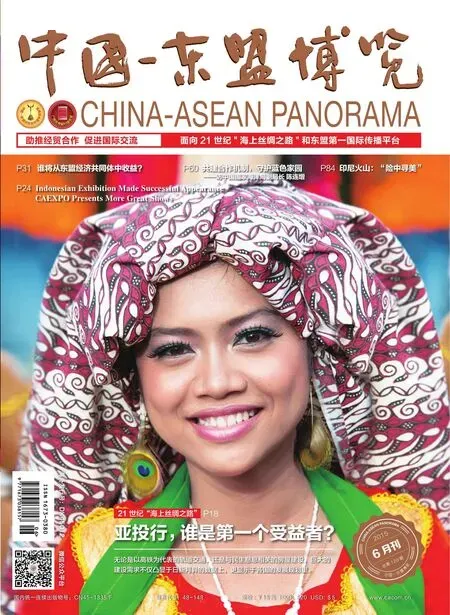CMQIP: Be Born with and For the Purpose of Industrial Cooperation
written by Li Min / translated by Gao Qianqian
CMQIP: Be Born with and For the Purpose of Industrial Cooperation
written by Li Min / translated by Gao Qianqian

China-Malaysia Qinzhou Industrial Park
I ndustrial park is the main form for regional economic development as well as industrial restructuring & upgrading. As the first industrial park co-built by China and Malaysia, the China-Malaysia Qinzhou Industrial Park (CMQIP), focusing on industrial development, is of great importance for the economic contacts and industrial cooperation between the two countries.
Construction work of the CMQIP has been advancing actively since 2012 when the park was officially opened. All the work involved, be it the infrastructure construction, industrial construction, investment promotion, or city development, prove to be a complicated system. However, every small step taken by the CMQIP means a big step forward for China and Malaysia in investment and industrial cooperation.
Be Born with Industrial Cooperation
In the general trend of economic globalization and regional integration, countries in the China-ASEAN Free Trade Area and Pan-Beibu Gulf area have formed their own “circle of friends”whose influence and status as a whole are rising continuously. How to deepen the cooperation between countries in the region is still a big problem facing these countries, which need to find a cooperation path that conforms to their own interest.
Project co-construction has become a beneficial trial. China and Singapore co-built the China-Singapore SuzhouIndustrial Park and Sino-Singapore Tianjin Eco-City in 1994 and 2007 respectively, providing new idea for the cooperation between countries in the region. In recent years, bilateral trade between China and Malaysia has witnessed dramatic development. By 2014, China had been Malaysia’s biggest trading partner for seven consecutive years. Driven by the booming bilateral trade, the two countries hope to establish a new platform for cooperation.
With regard to goods being traded, China mainly exports electronic products, machinery, equipment, instruments, furniture and knitted garments while Malaysia’s main exports are electronic products, fossil fuels, machinery, animal & plant oil, and rubber. Bird’s nest processing, grain & oil processing and halal food are also an important part in bilateral trade, which are closely related to resource exploration and further processing. If relevant industrial clusters are formed, there would be scale effect for production.
In terms of complementary advantage, intra-industry trade exists in China and Malaysia’s electromechanics and hightech industries. If the two countries could focus differently when participating in the international division of labor in the same industry to highlight their own product advantages, they could form a development pattern featuring strong complementarity and win more benefits for both countries.
“Industry” is a word of high frequency, no matter when talking about the bilateral trade between China and Malaysia, or the realization of international division of labor. Industrial park is of great advantage to the concentration of production factors, intra-industry horizontal cooperation, and vertical cooperation in industrial chains. Therefore, it is in fact a rational choice made by China and Malaysia to co-build an industrial park rather than an eco-park.
In October, 2011, then Chinese Premier Wen Jiabao and Malaysian Prime Minister Najib unveiled the nameplate for CMQIP, which marked the birth of the park in a land endowed with regional advantage, policy preference and environmental advantage. The park focuses on advanced manufacture, information technology and modern service industry.
Actions be Taken after Careful Planning
Industrial park shows the aggregation of resources. Aggregation alone would not yield any results. Without scientific planning, the aggregation of resources would result in waste of resources, rather than giving play to scale effect. So, scientific and proactive planning must be done before actions are taken.
According to the Strategic Planning for Industrial Development of the China-Malaysia Qinzhou Industrial Park (short for the Planning), the CMQIP has a total planned area of 55 sq. km., covering an industrial zone, R&D area, supporting service area, and a residential area. The industry land would be further divided into eight parts: equipment manufacturing, electronic information, food processing, materials and new materials, biological technology, modern logistics, comprehensive processing zone for Malaysian SMEs, and industry land for flexible use.
These industries have their own features

Development Path of the CMQIP
CHINA-ASEAN PANORAMAand development requirements. So, land use must meet the needs of industrial park development and the overall planning of the region, so as to let the eight industries “show their special prowess”. According to the Planning, the logistics area in the south of the park has the best transportation accessibility. Located in the most compact district of Qinzhou collecting and distributing system, it is the extended area of Qinzhou port-vicinity economic zone and will focus on modern logistics. The northern area is close to the residential and business area and has good ecological environment, which is reserved for food processing industries. And the southern part would develop palm processing industry. The logistics area in the northern area of the park is the optimal district to reach Nanning, capital of Guangxi, which is conducive to the linkage development of city logistics.
Apart from land use, the park has formulated an array of development paths from industrial planning guidance, policy system establishment, and traditional industry matching to strategic industry implantation. Based on this, the CMQIP has started its construction and is attracting projects to activate industrial development of the park.
It is reported that, from 2014 onward, the first three projects that entered the park, namely HEBABIZ, China-Malaysia grain and oil processing, and Malaysian hala food industrial park have begun their construction. Among them, the 780 million yuan China-Malaysia grain and oil processing project was put into production in April, 2015, which marked that real economy in the CMQIP had entered the stage of construction and operation. Besides, Bank of China Guangxi Branch has decided to provide financial support for enterprises investing in the park. With strong financial support, the park is bound to attract more enterprises.
Star Industry to Form an Industrial Brand
Compared to the China-Singapore Suzhou Industrial Park which has a history of over 20 years, the CMQIP is somewhat immature. This means that it has more development space in industrial planning and associated industries.
The development of industrial parks relies on the synergistic effect formed in industrial linkage and business linkage involving production, processing and selling. Hence, park managers should pay attention to the linkage between enterprises and associated industries, as well as the cluster development of industries in the park, so as to form its own brand.
“The CMQIP, as the flagship project between China and Malaysia, will invite investment from all over the world. Only with open-minded exploration, creative policies, carefully selected industrial arrangement and an idea that confirms to the world economic pattern could the park develop vigorously”, said the expert.
It is reported that the CMQIP will focus on the seven government-supported key industrial industries and enhance the cooperation with Malaysia in halal food, bird’s nest processing and palm oil etc., with the purpose of inviting integrators and leading enterprises to establish star industries in the park.
On the one hand, efforts must be made to strengthen cooperation with Malaysia’s Halal Food Association, Islam Association and Halal Industry Development Corporation (HDC), speed up the construction of halal food authentication center in the park, and introduce more Malaysian halal food industries to the park. On the other hand, the park should attract bird’s nest processing enterprises and leading trade enterprises from Malaysia and Indonesia to promote bird’s nest industrial chains. Also, efforts must be taken to intensify the communication and coordination with China’s AQSIQ and Malaysia’s Ministry of Agriculture etc., and push the implementation of “Joint Check of Two Countries”to facilitate raw bird’s nest import. Moreover, the park should reinforce the application of China’s Beidou satellite etc. in Malaysia’s palm oil plantation and production to highlight key industries in the park.
China’s industrial park development has gone through three stages: industrial concentration zone, city and industry integration zone, and science & technology innovation zone. The expert believed, in the context that China’s economy continues to expand and integrate into the world economic pattern, the CMQIP should further upgrade its planning, high-end industrial agglomeration, city and industry integration, and match the science and education resources with world trade and investment rules to create the 4.0 version of Chinese industrial park. Only by this could the park seize the godgiven opportunity for industrial park and regional industry development.

